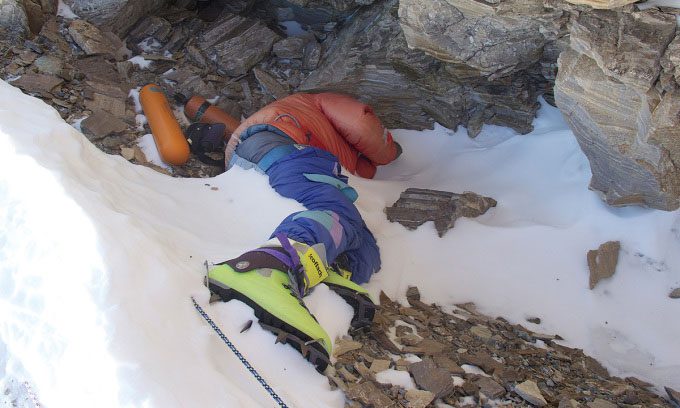Located at an altitude of over 8,000 meters, the Rainbow Valley contains approximately 200 bodies that cannot be retrieved due to the harsh terrain and environment.
Climbing Mount Everest is an extremely dangerous journey. Over the years, many individuals have lost their lives while attempting to conquer the world’s highest peak. Just this year, the death toll may have reached 17, IFL Science reported on June 6.

The body of “Green Shoes” rests about 340m from the summit of Everest. (Photo: Twitter/Whoacity)
The journey to conquer Everest typically includes a trek to base camp (about 8 days at an average pace) at an altitude of approximately 5,300 meters. From there, climbers must spend an additional 40 days acclimatizing to the high altitude and low oxygen levels to reach the summit.
As climbers ascend, atmospheric pressure decreases, oxygen molecules disperse, and the air becomes thinner. Therefore, the greatest challenge arises when reaching the “death zone” — the area above 8,000 meters on Mount Everest. At this altitude, the air is so thin that most people, except for the most resilient climbers, require supplemental oxygen to continue their ascent.
Climbers face the risk of acute mountain sickness, a severe condition that occurs when there is insufficient oxygen for the brain at high altitudes, leading to disorientation and energy depletion. Alongside dangers such as avalanches, falls, and frostbite, Everest claims the lives of many professional climbers each year.
So what happens to climbers’ bodies if the worst occurs while attempting to summit Everest? The air is too thin for helicopters to retrieve the bodies. Thus, the only option is for other climbers to risk their lives to bring back the deceased.
However, many bodies are left on the mountain, serving as a grim reminder of the dangers posed by peaks over 8,000 meters, and they even become landmarks. Climbers know they are on the right path when passing certain well-known bodies, such as “Green Shoes” or “The Sleeping Beauty” (which has since been relocated from the climbing route). Nonetheless, the majority of those who perish will rest in the “Rainbow Valley.”
Rainbow Valley is an area within the death zone of Everest, adorned with the bright clothing of those who have lost their lives and been pushed off the climbing route. This area is dotted with oxygen tanks and colorful tents and is estimated to contain around 200 bodies, though the exact number is unclear.
Serving as a graveyard for those who have died and must be left in the death zone, Rainbow Valley lies at an altitude of over 8,000 meters, below the northern summit of Everest. The bodies remain here because retrieval and transport are prohibitively expensive, dangerous, and often unsuccessful. The valley has almost become a legendary area among climbers and is greatly respected due to the many who rest there.


















































